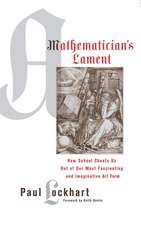Teaching Mathematics through Reading: Methods and Materials for Grades 6-8
Autor Faith Wallace, Jill Shivertakeren Limba Engleză Paperback – 14 oct 2008 – vârsta până la 17 ani
Preț: 222.74 lei
Preț vechi: 334.53 lei
-33% Nou
Puncte Express: 334
Preț estimativ în valută:
42.63€ • 46.29$ • 35.81£
42.63€ • 46.29$ • 35.81£
Carte tipărită la comandă
Livrare economică 23 aprilie-07 mai
Preluare comenzi: 021 569.72.76
Specificații
ISBN-13: 9781586833244
ISBN-10: 1586833243
Pagini: 112
Dimensiuni: 216 x 279 x 8 mm
Greutate: 0.27 kg
Editura: Bloomsbury Publishing
Colecția Linworth
Locul publicării:New York, United States
ISBN-10: 1586833243
Pagini: 112
Dimensiuni: 216 x 279 x 8 mm
Greutate: 0.27 kg
Editura: Bloomsbury Publishing
Colecția Linworth
Locul publicării:New York, United States
Notă biografică
Faith H. Wallace is an assistant professor of Adolescent Education and Literacy at Kennesaw State University in Kennesaw, GA. Jill Shivertaker is a seventh grade mathematics and social studies teacher at Sammy McClure, Sr. Middle School in Dallas, Georgia.
Recenzii
Extension activities in tested strands are plentiful in this excellent resource. Each section includes a book summaries,objectives, activity sheets, and brain-twisting challenges. Students expand on mastered knowledge and connect to literature, their families, and their world. I see this as an outstanding resource for Pre-Algebra/Algebra classes.
This resource provides middle school teachers and library media specialists with alternative text sources and activities to support the development of mathematics as well as reading skills. Section I introduces three types of texts: informational trade book, literature, and environmental print (such as lottery tickets, credit card solicitations, directions, and nutritional information). For each text type, the authors provide annotated bibliographies and lists of potential resources. Also provided in Section I are lists of materials and supplies for activities. In Section II, ideas, strategies, activities, detailed lesson plans, and reproducible student worksheets using these texts are given for each of the content standards set forth by the National Council of Teachers of Mathematics. Subjects taught and illustrated include numbers and operations, algebra, geometry, measurement, and data analysis. An appendix lists current mathematical picture books. Wallace teaches adolescent education at Kennesaw State University. Shivertaker is a middle school teacher.
Library media and technology specialists for grades K-12 receive a fine survey showing how to use all kinds of texts to help students learn mathematical concepts. From informational trade books and literature to learning numbers, geometry, algebra, and data analysis, chapters survey the available literature and offer annotated biblographies to help in classroom text selection and activities. Education and librarian collections will find this an excellent pick.
This resource provides middle school teachers and library media specialists with alternative text sources and activities to support the development of mathematics as well as reading skills. Section I introduces three types of texts: informational trade book, literature, and environmental print (such as lottery tickets, credit card solicitations, directions, and nutritional information). For each text type, the authors provide annotated bibliographies and lists of potential resources. Also provided in Section I are lists of materials and supplies for activities. In Section II, ideas, strategies, activities, detailed lesson plans, and reproducible student worksheets using these texts are given for each of the content standards set forth by the National Council of Teachers of Mathematics. Subjects taught and illustrated include numbers and operations, algebra, geometry, measurement, and data analysis. An appendix lists current mathematical picture books. Wallace teaches adolescent education at Kennesaw State University. Shivertaker is a middle school teacher.
Library media and technology specialists for grades K-12 receive a fine survey showing how to use all kinds of texts to help students learn mathematical concepts. From informational trade books and literature to learning numbers, geometry, algebra, and data analysis, chapters survey the available literature and offer annotated biblographies to help in classroom text selection and activities. Education and librarian collections will find this an excellent pick.

![Maths Frameworking -- Pupil Book 2.1 [Third Edition]](https://i4.books-express.ro/bt/9780007537747/maths-frameworking-pupil-book-2-1-third-edition.jpg)














